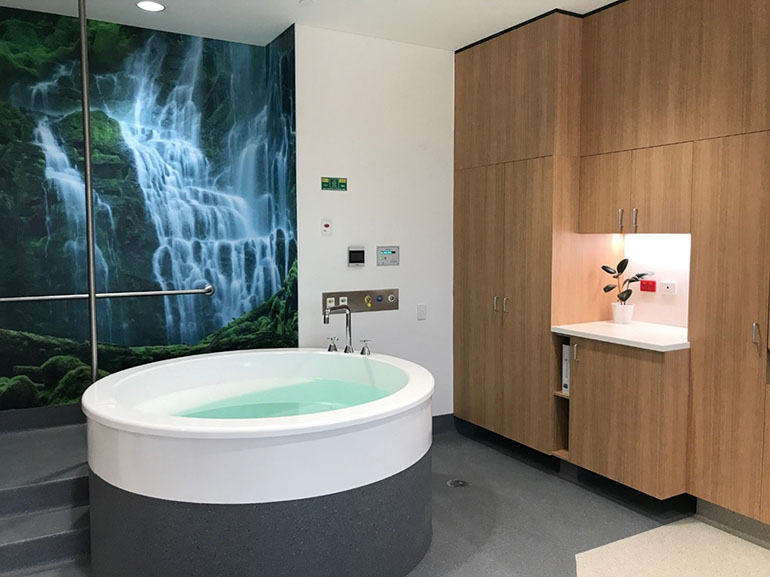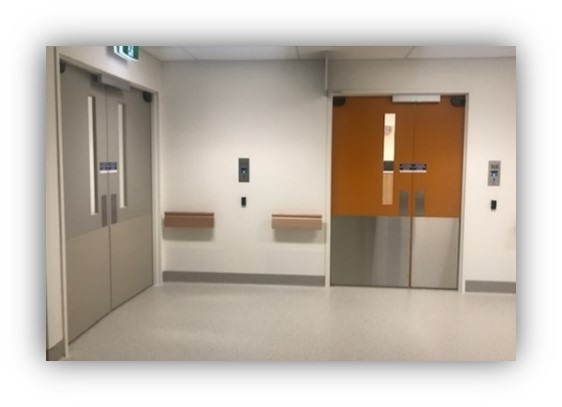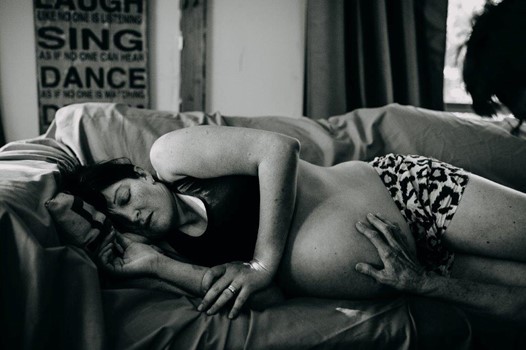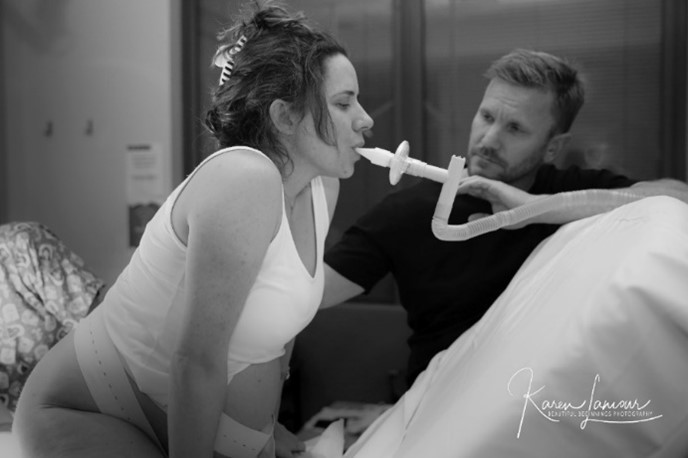Labour and Birth
Birth Unit
Welcome to our state-of-the-art birth unit. Our beautifully designed facility boasts eight spacious and comfortable birth rooms, each thoughtfully designed to provide a calming and peaceful environment for expectant families.
Each room comes equipped with a relaxing bath for labouring mothers. To ensure the safety and comfort of both mother and baby. We also offer wireless fetal monitoring technology, allowing for freedom of movement during labour without the constraints of traditional monitoring equipment.

Our collaborative staff of highly trained and compassionate healthcare professionals are committed to providing exceptional care throughout your birthing experience. We believe that every birth is unique and should be approached with individualised attention and care. We strive to provide a safe and supportive space for families to welcome their newest addition to the world.
You can contact the Birth Unit 24 hours a day on 9113 2125 to speak with a midwife.
The Birth Unit is located on Level 2 of the Tower Ward block.

Who can come with me and support me during labour and birth?
You may bring two birth partners with you to Hospital. This could be your partner, mother, sister, doula, or other support person. If you are not in labour and need to stay overnight, we may ask your support person to go home overnight so everyone can get some rest, then they can return in the morning. If you go into labour overnight, we will call your support person to come back into the birth unit.
Supporting a woman in labour
Having a support person in labour and birth can help your experience. For more information about birth support partners, follow this link.
What do I bring?
Refer to the NSW Health ‘Having a Baby Book’ for information on what to bring.
- Your baby continues to grow and develop until 39 to 42 weeks. We know that every week your baby continues to grow inside you makes a difference to their short-term and long-term health and developmental outcomes.
- For pregnancies without complications, being born as close as possible to your due date or after your due date, and waiting for labour to start on its own, is usually best for you and your baby.
- In some cases and for varies reasons, it may be safer to have a planned birth before your due date. A planned birth is when a woman gives birth to her baby at a specific time, by an induction of labour or caesarean section. Sometimes babies need to be born before their due date to help reduce the chance of complications, especially if you or your baby are unwell. Planning your baby’s birth will be done in consultation with the obstetric doctors, midwives and yourself.
- For more information about timing of birth, refer here
Birth Preferences
- An important part of preparing for your baby’s arrival is to explore the options available to you to assist you in birthing and caring for your baby in the early days.
- It is important to remember that every pregnancy, every woman and every family is an individual experience. Some preferences of others may not be the same preferences that you have.
- Exploring your options during your pregnancy will help you to make informed decisions about your options. Pre-birth planning allows you to have time to understand these options and ask your Midwife or Doctor questions about your options.
- Attending a preparation for birth and parenting class is recommended to help you in the decision-making process.
- It important to make your birth preferences known to your care provider and discuss the options with them so they can help you with your decision-making. The best way to do this is to document your birth preferences in writing and bring them to your appointment to discuss them with your care provider.
- This document should be an outline of the decisions you have made but should not be a rigid set of rules for your labour and birth. It is important to know that labour and birth can be unpredictable and so flexibility and knowledge of interventions that may become necessary for the health and safety of you and your baby is important. Interventions such as assisted births or emergency caesareans are unplanned, but you may still have some preferences around these recommendations, and it is important to discuss these with your care provider. This document should be a guideline of your preferences not a strict birth plan.
- Your birth preferences can include options such as methods of remaining active in birth, who your support people will be, how your support people will assist you, preferences for pain relief options and what your preferences for your baby’s care are.
- It is important to discuss your preferences with your support people so that they will be aware of what your birth preferences are too.
Induction of labour
- If an induction of labour is recommended for you, your doctor and/or midwife will discuss the details with you. Discussing an induction of labour is important so you are well informed of the process, you can ask questions, and you can make an informed decision. Before beginning the induction, you will be asked to sign a consent form.
- Induction of labour can be done in different ways and will depend on your situation. To help decide which method is suitable for you, an internal examination will normally be recommended to check how ready your cervix (neck of the uterus) is for labour and birth. The induction may involve the use of a catheter (tube) inserted into your cervix, gel which is inserted into your vagina (prostin), breaking the waters in front of the baby, or medicine (oxytocin) given through a drip. Your induction may involve one or more of these steps to help prepare your body and bring on labour.
Caesarean Section
- If a planned caesarean is required, a doctor will discuss this with you in the antenatal period and provide you with information about the procedure.
- In some cases, women require an emergency caesarean section. Staff will discuss this with you at the time if this is recommended.
* Please note sometimes when a birth is planned, it may need to be rescheduled. Please be aware that if this happens it will be in consultation with maternity unit managers and consultant obstetricians, for reasons relating to activity, acuity, and service capabilities at that time. If this happens, new times will be discussed with you by managers as close as possible to the cancelled date.
- Every labour and birth is different and varies on when it starts and how long it takes. Your midwife or doctor can answer any questions you might have about your labour and birth, and what you and your partner can do to prepare.
- Most women experience one or more of these signs when labour is beginning:
- Regular contractions/period-like cramps.
- A ‘show’.
- Waters breaking.
- Please call the birth unit if you think you are going into labour on (02) 9113 2125
- Labour takes time. The time taken for each stage will vary from woman to woman. Everyone is different.
- Stage 1 - when your cervix is opening.
- Stage 2 – when the baby is being born.
- Stage 3 - when the placenta is delivered.
- Refer to the NSW Health ‘Having a Baby Book’ for more information .

- In an active birth you have the freedom to move around the room, be upright, and change positions that feel comfortable to you during labour. Being active may help you manage contractions and progress in labour.
- Active birth is giving birth naturally in a position of your choice.
- Active birth is backed by research and evidence and is known to have important benefits for women and babies in labour and birth. These include:
- Reduces the risk of medical interventions including inductions, epidurals, and caesarean sections.
- Squatting, or hands and knee positions, help to open the pelvis, allowing more room for baby to travel through.
- Shorter labour time.
- Labour is less painful as contractions are more manageable when moving around and upright.
- Women feel more in control of their birth process.
- Better oxygen flow to baby as being in upright positions for birth allows for a better flow of blood to the baby.
- Make the most of gravity. Pushing in an upright position allows gravity to do its job and help baby travel through the birth canal.
- Your partner may feel more involved and can actively participate in supporting you. It also creates a rewarding bonding experience for all.
- Has the potential to result in less trauma to baby. An active birth can result in fewer interventions and a shorter labour, which may reduce the likelihood of stress to the baby.
- All midwives at our Hospital are trained in active birth and how to assist active labour and birth. Equipment to support you in active birthing is available including:
- Birthing balls (including peanut balls)
- Birth mats
- Bean bags
- Double-headed shower
- Large baths
- You are also welcome to bring your own items to support you in active birthing.
Pain relief options during labour and birth
- Experiencing pain in labour and birth is normal and is felt in different ways by everyone. Understanding the choices of pain relief is an important part of getting ready for the birth of your baby.
- Having a baby is a natural process, but every woman is different, and every birth experience is unique, so pain relief options vary.
- There are different ways to manage pain during labour. Available pain relief options include:
- Non-medical forms of pain relief:
- Active birthing - being active and mobile during labour, and using birth props (birthing balls, birth mats, beanbags). Please see more information about Active Birth benefits in the Active Birth section above.
- Transcutaneous electrical nerve stimulation (TENS) - you will need to provide your own machine.
- Heat packs - provided by the Hospital.
- Double headed showers in each birth room.
- Bathtubs for water immersion and birth are available in each birth room for suitable women
- Medical forms of pain relief include:
- Sterile water injections.
- Nitrous Oxide (laughing gas).
- Morphine injection (medicine).
- Epidural (patient controlled).
- Non-medical forms of pain relief:
- Please click here for more in depth information on pain relief in the "Having a Baby" book.
- Talk with your midwife or doctor about the pain relief options available to you

Tearing during birth, what is the perineum and how to protect it
Many women worry about having tearing during birth. The perineum is the small area of tissue between the opening of your vagina and the opening of your back passage (anus). Speak to your midwife or doctor about the risk of tearing.
Skin to skin after birth
Skin to skin is when your baby's bare body is placed on your bare chest, with no clothing or wraps between. We support you to have skin to skin with you baby immediately after birth or as soon as possible.
With your consent, at birth, your baby will receive their Hepatitis B vaccination and Vitamin K injections.
Hepatitis B
Click here for more information about Hepatitis B vaccine
Vitamin K
Click here for more information about the Vitamin K injection
Speak to the midwife looking after you if you plan to go home from the birth unit. There are some important checks you and your baby need following the birth. These checks will be done as soon as possible but will require you to stay at least 4 hours following the birth.